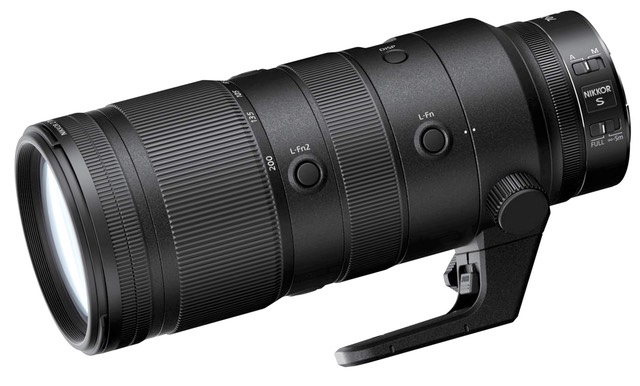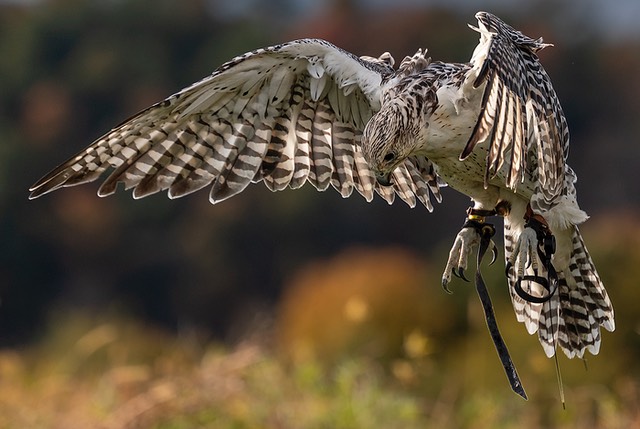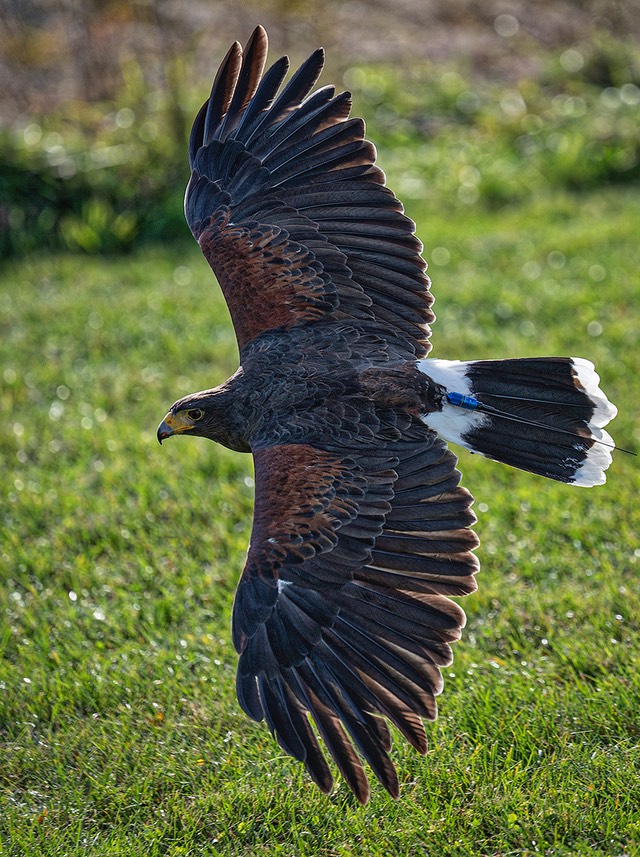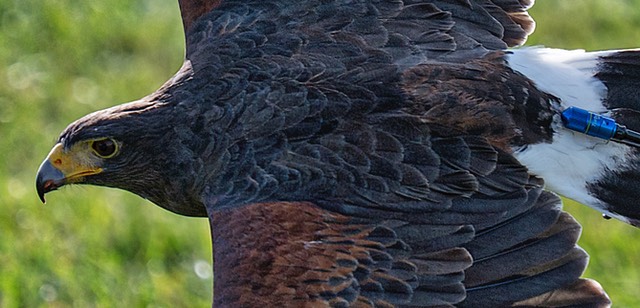
What is It?
The 70-200mm f/2.8 S is the second in Nikon's speed zoom trio (the 24-70mm was the first, the 14-24mm the latest). In terms of establishing the Z cameras more fully in the pro realm, this f/2.8 trio of zooms is both necessary and watched closely. The 24-70mm f/2.8 S is a superb lens. You're probably wondering if the 70-200mm f/2.8 lives up to that (see performance section near bottom).
While Canon went a different route with their RF 70-200mm f/2.8 design—collapsing for travel—Nikon stuck to the basic shape and formula established by the 70-200mm f/2.8E FL. The Z-mount version is slightly longer than the F-mount version, but retains the "does not extend or rotate" design that we're all now comfortable with.
Lengthwise we're at 8.7" (220mm), while the diameter is 3.5" (89mm). The included HB-92 lens hood extends the length by 2.5" and the max diameter to about 4". The F-mount lens is 8" x 3.5" by comparison. Weight is also very similar between the DSLR and mirrorless versions of the lens: 48 ounces (1359g) for the footless Z lens, 47.9 ounces (1357g) for the footless F lens.
The 70-200mm f/2.8 S includes a removable tripod foot. This foot is a little lighter than the one for the F-mount (and I also found it a little more secure). When you add everything up (lens, foot, hood, FTZ if needed), the Z version of the lens does drop some weight from your bag: 53.1 ounces (1504g) versus 57.3 ounces (1624g), but that's not particularly significant. Nikon makes a point about the foot of the tripod collar being bigger than previous models, but it's a modest change and still doesn't quite make the foot into a carrying handle, in my opinion. Most of us are going to replace the foot with an Arca plate foot, such as those made by RRS and Kirk Enterprises.
Overall build quality is typical S-line Z: a sturdy polycarbonate outer shell protecting the inner metal-body chassis. Extensive seals are used to keep the lens dust and "drip" resistant.
Optically, the new lens is both a new design and an old design, which explains a lot of the similarity. The front seven elements (of 21) pretty much capture and present the scene the same as the F-mount version (22 elements total). It's what happens after that which is quite different. The change appears to be driven (pardon the pun) by the dual autofocus motor setup, which also changes the VR elements positioning some. The dual STM focus system is quiet and fast.
The lens has built-in VR (though no switch to control it). Nikon claims up to 5.5 stops (CIPA), though doesn't specify if this is also true for a camera that doesn't have sensor VR, such as the Z50.
21 elements in 18 groups is complex, but not overly complex. What's more complex is that we have two aspherical and 10 (!) low dispersion elements. Curiously, Nikon doesn't make much marketing noise about it, but the S version also has the same FL element up front to save weight. That also shifts some of the weight balance closer to the camera from the earlier Nikon 70-200mm designs.
Coupled with optical design is a range of coatings. At different points in the lens it has Nano coating, ARNEO coating, and on the front element Fluorine coating to shed water and dust. How do Nano and ARNEO coating differ? It has to do with the angle of light. ARNEO suppresses ghost/flare on near vertical incident light, while Nano suppresses it on light coming at a diagonal. Nikon doesn't specify where the coatings are used within the optical design, though.
This lens also features an SR lens element, which is used to correct on-axis color aberrations for short wavelengths. This is similar to Canon's BR elements, but Canon uses resin for those elements, while Nikon uses a new glass formulation. Nikon makes claims about back light resistance on this lens compared to the competition. They also claim that this helps achieve higher resolution performance than the F-mount version of this lens.
Up front we have a 77mm filter ring, which can be used at the same time as the lens hood (though Nikon hasn't thought to make a lens hood door to control polarizers, as Canon has).
Nikon designers claim that control of VR is "easy" from the camera menu system, which is why they left off any switch for VR on the 70-200mm f/2.8 S. We do get two different L-Fn buttons and a button to control what's shown (if anything) on the small OLED display on the top of the lens (I'll discuss this more in handling). A A/M switch and a focus limiter switch round out the controls on the lens itself.
The multi-motor focus system has two basic benefits. First, the speed to move focus position is improved, but by separating the focus elements Nikon has also been able to keep the minimum focus distance low.
The zoom ring is up front on the lens and rotates 80°. It is marked at 70mm, 85mm, 105mm, 135mm, and 200mm.
The focus ring is the middle ring on the lens, and as with all current Z lenses other than the NOCT, is focus by wire. Close focus changes with focal length. At 70mm you can focus to 19" (.48m) and get a maximum magnification of 1:4.7, while at 200mm you can focus to 38" (.96m) and get a maximum magnification ratio of 1:4.6. As suggested by the this data, there is minimal focal length breathing with this lens. Nikon had initially said the lens would have no focus breathing, either, but that has changed to "virtually no focus breathing."
The lens has a DISP button that controls a small OLED panel that can display focus, depth of field, focal length, and aperture. This display is off by default; you must press the button to see current information (see handling, next). A focus range limiter allows you to set 5m-infinity instead of the full range, should you desire. The lens also has an A/M button to set autofocus or manual focus.
We get two (actually five) function buttons on the lens: L-Fn just behind the focus ring, and four L-Fn2 buttons arrayed at 90° around the lens just behind the zoom ring. Plus the lens has a third customizable control ring right near the camera body. Overall, there's a lot of customization that can be done to controls on the lens, and serious shooters are going to need to study that carefully and figure out which changes work for them.
The 70-200mm f/2.8 S is made in Thailand and sells for US$2599, but only includes a light cloth swaddle (CL-C3), not a full case. Moreover, Nikon doesn't offer an accessory carrying case (the F-mount lens comes with one). Both the recent TC-1.4X and TC-2.0X can be used on the lens (I'll have more to say about those in another, later, review, but for now just let me say that the TC-20X provides a very close focusing, seriously good 140-400mm f/5.6 lens that doesn't exist in the Z lineup at the moment).
Source of the reviewed lens: purchased via NPS Priority Purchase
How's it Handle?
Having now used some of the top Canon RF lenses, I'm going to be blunt: Nikon needs to up their game.
Let's start with the "third" ring. Not only does Canon provide more possible customization of that ring on the R5 and R6, but the Canon rings have a subtle set of detents to them. This means that an accidental brushing either doesn't tend to happen, while the ring provides feedback to the user when it does happen. Nikon's extra ring is freewheeling, though a bit stiff. Still, it's easy to bump it and not know whether you've changed something without looking at your settings. Since the only things we can set with that ring are aperture, exposure compensation, and ISO, I'd rather have the feedback that the Canon setup provides than Nikon's freewheel.
The OLED display on the top of the lens is an interesting touch, and definitely easy to see in low light when active. But I question its usability. First, if the camera has gone into standby, the display won't light. To conserve power, it doesn't stay lit as long as your Standby setting. Pressing the DISP button on the lens doesn't bring the camera out of standby or light the lens display when the camera is in Standby. These all seem like complete design misses to me.
What you can see is focal length, aperture, and focus point (with a DOF indicator that is not specified as to CoC value; as a certain politician might say, "come on, man"). Of these capabilities, only the latter seems particularly useful on this lens. Sure, I can see that I'm at 79mm instead of somewhere closer to 85mm than 70mm on the zoom ring, but of what practicality is that, and I have to press a button to see it in the first place. Maybe even press buttons multiple times (yuck) due to camera standby. I suppose Z5 users who don't have a Top LCD on the camera will appreciate being able to see aperture setting, but again, this is a button-intensive operation for an important setting that should be always visible.
Finally, we have the focus point and DOF scale. Given that we're talking about a telephoto zoom and one that is likely to be used frequently at fast apertures, it isn't particularly likely that you're going to be considering depth of field. And if you are, I doubt that you'd use Nikon's "loose" standards for that, let alone be able to read the line that appears accurately enough to know anything useful.
There is one time when the OLED display on the lens shines: when you're using a teleconverter. You guessed it: it shows the corrected aperture and focal length (and DOF, but again, not to the precision I'd want it).
To me, the "extras" on this lens—OLED display and extra ring—are more gimmick than useful. They don't solve user problems while creating new ones. Yuck. On the wide angle and mid-range zooms, the DOF capability comes more into play, but for a telephoto zoom I'm not seeing how I'd ever use that given how imprecise it is.
The removable foot design is the same as with many previous Nikon telephoto zooms, though seems a little more sturdy. With the locks fully in place, I see no real vibration caused by the tripod collar, as I have with some previous Nikkors. We're still all going to replace the foot itself with a third-party foot that has an Arca-style plate, though ;~). Do we not have any photographers in the Nikkor design teams?
Finally, that missing VR switch: sorry, but that was a mistake. VR is buried either in the Quick menu or deeper in the full menus. If VR were able to be assigned to one of the customizable buttons, I wouldn't complain about this, as we'd still have a finger-level-control. But while removing the switch allows for slightly better weatherizing and less manufacturing complexity, it removes a function that many of us used.
How's it Perform?
Focus: silent and fast. If you're seeing anything that isn't fast, it's due to the camera and its response to low light, not the lens. In other words, in low light, the Z5 isn't as snappy with this lens as the Z6 is. But that has nothing to do with the lens.

Image Quality: Nikon makes the claim "Ultimate aberration correction—virtually zero flare, ghosting, coma or chromatic, spherical and axial aberrations, even at the far edges of the frame." Virtually zero is not zero, so let's see how they did...
Sharpness: This isn't as easy to describe as it might seem. Obviously, I was comparing my F-mount FL version with this Z-mount S version. But in doing so, the differences are small enough that it isn't always clear who the winner is. That's especially true since I used the word "superb" in my F-mount FL version review. I don't have a higher category, nor do I have any good words to suggest nuance at that level. So the short version is this: the 70-200mm f/2.8 S is again overall superb. Again, it's sharp for a zoom, sharp for a prime, sharp for any lens.
Nikon's MTF charts suggest that the Z-mount S version is slightly better in the corners than the F-mount FL version.
In that detail we do have some small things to talk about. At 70mm, the lens is excellent in the center out through the DX crop and very good in the corners wide open. The corners continue improving to reach excellent by f/5.6. In the mid-range, the lens is very good in the center and corners, and improves to excellent in both cases by f/5.6. Worst case seems to be around 135mm. 200mm is probably the second weakest, but still clearly very good in the center through the DX crop and good in the corners wide open. By f/5.6 the telephoto end just snaps into acuity that's above my rating expectations.
On my samples, the S version is clearly better than the F-mount FL version in the corners at 70mm wide open. That's true of the mid-range, too. At 200mm, my two versions are much closer, though my S version still is ever so slightly better. One thing that does need to be taken into account is focus distance. My comments so far are based on more close in and test chart focus. At infinity focus I see a slightly weird reversal of some of my comments: the mid-range becomes slightly worse in the center and slightly better in the corners on the S, for example. At 200mm, the corners also soften a bit wide open, though central area stays sharp on the S.
While I can find focal length/aperture combinations where my F-mount FL is better at something, it's rare; more often than not the S version is better.
I don't detect any clear focus shift, though it does appear that at 200mm there might be a smallish shift forward, but I suspect this isn't focus shift but some spherical aberration. Field curvature also seems to be very well controlled. Coma is very well controlled (better than the F-mount version).


Chromatic Aberration: With lens corrections enabled, you're not going to see any. Even longitudinal chromatic aberration is really well under control on this lens to the point where it is ignorable (200mm has a bit more than 70mm, but it's still low). Put simply, the S version is better than the F-mount version in all aspects of CA, and the F-mount version was already quite good.
Vignetting: If the S version has a drawback compared to the F-mount one, I'd say it's probably in this category. I was hoping for better performance. The built-in corrections do an excellent job at 70mm. By f/4 there isn't any vignetting apparent (still a bit there that can be measured). At 200mm, the same is basically true, but the overall base vignetting is quite high in the corners (and elliptical).
Linear Distortion: A slightly complex but low barrel distortion at 70mm, and clear (>1.5%) pincushion distortion at 200mm. The in-camera corrections do a good job with both.
Flare: Near-frame-edge light sources produce some clear, though somewhat faint ghosting and scattered color components.
Bokeh: At 200mm and f/2.8 focused in shorter distances it's very easy to provoke full-out out-of-focus areas, so it's worth paying attention to bokeh attributes. Good news and bad here. The good news is that while there's a bright rim on out of focus highlights, it has no real coloration. There's also very little onion skinning. The bad news is that the lens definitely produces cats-eyes as you move to the corner, and not just mild ones. Also, as I keep finding with Nikkors, some stopped down apertures show non-symmetric blade shapes.
A word of caution: my comments here apply to my samples. Because they were supplied under NPS Priority Purchase, it is possible that Nikon cherry-picked the lenses I purchased. What's a little disturbing is that I'm seeing some sample variation with the S lenses that I'm not used to in Nikkors. You can find reviews of the 70-200mm f/2.8 S that don't completely agree with what I wrote above, particularly where it is compared to the 70-200mm f/2.8E FL version. Also, note that if you use test charts at closer focus distances, the corners don't look nearly as good with this lens. So many of those just running a quick test chart check aren't necessarily reporting this lens correctly.
Final Words
This is a tough call. The 70-200mm f/2.8E FL is an excellent lens, the best I've seen in that focal range from anyone until the 70-200mm f/2.8 S came along. But I'd say the two Nikkors are within a hairbreadth's distance of one another in terms of optical performance, and what I see in differences could very well just be sample variation.
There isn't a real size or weight advantage to the Z-mount version. The OLED display is mostly gimmicky. The lack of a direct VR control switch is a mistake. So at first there doesn't seem to be an advantage to choosing the S version.
Well, there is one fairly clear advantage: the teleconverters. Obviously, Nikon was designing the lens and converters in tandem, and it shows. If you're the type that's going to put a TC on your 70-200mm, get the S version and sell your F-mount version. Three sets of connectors (FTZ, TC, lens) is simply asking for trouble, and the new TCs are better on the S lens than the old TCs were on the F lens. Not perfect, mind you, but clearly better.
Of course, if you don't have the 70-200mm f/2.8E FL, your choice is far easier: get the Z mount lens.
Which brings me to a strange final position. I highly recommend this lens except when I don't. In the case of the 24-70mm f/2.8 S I could clearly say "leave your F-mount version behind." I can't say that with the 70-200mm f/2.8 S. Some of you should just stick with using the F-mount lens on an FTZ Adapter, especially if you never use teleconverters.
I've rushed this review a bit for a reason: right now Nikon has the F-mount lens on sale for US$700 less than the Z-mount version. That's a pretty wide discrepancy for lenses this good. For some of you it very well may be the right thing to do to buy the F-mount version and use it. The only significant thing you're giving up is the native teleconverters.
Highly Recommended (2020, 2021, 2022) (but some should stick with their FL F-mount version)